#early mammals
Text

This absolutely amazing eohippus figure arrived from the incomparable Kitty Cantrell studios. This creature is 9" long! It's going to be amazing, no matter whether I paint it or not. You can see Kitty's fabulous work at http://kittycantrell.com
5 notes
·
View notes
Text



All the early mammals looked like rats.
The evolutionary divine perfection.
22 notes
·
View notes
Text
Walking in the Ischigualasto Formation
"Walking in the Ischigualasto Formation" a Argentinian cowgirl beholds the amazing fauna of the Triassic Period.
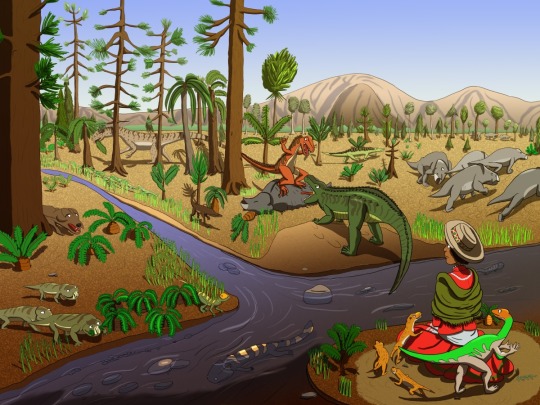
View On WordPress
#adobe photoshop#argentina#artistatwork#Commissions Open#Cowgirl#Digital Art#DigitalPainting#dinosaurs#early mammals#early reptiles#Environment Art#Environment Design#environmental art#herbivores#paleontology#Palo Art#Triassic Period#Wacom Tablet
13 notes
·
View notes
Text


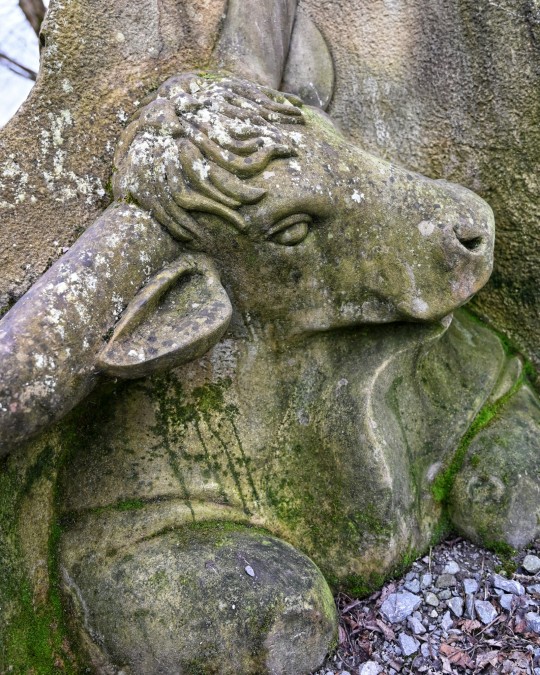

'Aurochs' by Jennifer Tetlow, Dales Countryside Museum, Hawes, Yorkshire Dales
#ice age#stone age#auroch#cattle#prehistoric mammals#mammals#ancient living#ancient culture#ancient farming#farming#archaeology#prehistoric#prehistory#extinct#early farmers#yorkshire
3K notes
·
View notes
Text


The archeocete Perucetus colossus dives through a coastal bloom of jellyfish in the Pisco Basin (southern Peru), some time during the Eocene (with bonus multiview).
I originally intended to add epibionts to this reconstruction (reflecting the specialized communities found on many living whales, especially baleen whales). Yet, interestingly, it appears that most animal epibionts and ectoparasites of modern cetaceans, such as whale barnacles (Hayashi et al. 2013) and remoras (Friedman et al. 2013), only appeared in the Neogene or late Paleogene, or have a poorly known (co-)evolutionary history, like whale lice (Pfeiffer 2009, Iwasa-Arai & Serejo 2018) and pennellids (large parasitic copepods) (Hermosilla et al. 2015). So, no epibionts* for big lad Perucetus!
References and notes about the reconstruction:
*animal epibionts. Unicellular eukaryotes like diatoms were most likely present on early cetaceans, given their prevalence on modern large marine animals (Ashworth et al. 2022). Of course, it is possible that other animals (i.e., early, less specialized representatives of modern groups, or different taxa altogether) were also already exploiting the surfaces offered by these early whales; however, this remains entirely speculative.
The reconstruction of Perucetus proposed in its original description (Bianucci et al. 2023) includes some rather odd (if interesting) choices about soft tissues, including limbs with webbed and distinguishable fingers, and a manatee-like tail. While these choices might be defendable in light of the rather basal status of Perucetus among cetaceans, I opted for a more derived look based on the assumption that fully marine cetaceans like basilosaurids would have probably rapidly acquired hydrodynamically favorable adaptations, pushing them towards a more familiar Neoceti-like appearance (even though Perucetus itself was likely a poor swimmer (Bianucci et al. 2023), it seems likely to me that this was a secondarily acquired trait, given the less extreme morphology of other basilosaurids).
Reconstruction in the multiview scaled to ~18 m in length after the estimations of Bianucci et al. (2023).
References:
Ashworth, M. P., Majewska, R., Frankovich, T. A., Sullivan, M., Bosak, S., Filek, K., Van de Vijver, B., Arendt, M., Schwenter, J., Nel, R., Robinson, N. J., Gary, M. P., Theriot, E. C., Stacy, N. I., Lam, D. W., Perrault, J. R., Manire, C. A., & Manning, S. R. (2022). Cultivating epizoic diatoms provides insights into the evolution and ecology of both epibionts and hosts. Scientific Reports, 12(1), Article 1. https://doi.org/10.1038/s41598-022-19064-0
Bianucci, G., Lambert, O., Urbina, M., Merella, M., Collareta, A., Bennion, R., Salas-Gismondi, R., Benites-Palomino, A., Post, K., de Muizon, C., Bosio, G., Di Celma, C., Malinverno, E., Pierantoni, P. P., Villa, I. M., & Amson, E. (2023). A heavyweight early whale pushes the boundaries of vertebrate morphology. Nature, 620(7975), Article 7975. https://doi.org/10.1038/s41586-023-06381-1
Friedman, M., Johanson, Z., Harrington, R. C., Near, T. J., & Graham, M. R. (2013). An early fossil remora (Echeneoidea) reveals the evolutionary assembly of the adhesion disc. Proceedings of the Royal Society B: Biological Sciences, 280(1766), 20131200. https://doi.org/10.1098/rspb.2013.1200
Hayashi, R., Chan, B. K. K., Simon-Blecher, N., Watanabe, H., Guy-Haim, T., Yonezawa, T., Levy, Y., Shuto, T., & Achituv, Y. (2013). Phylogenetic position and evolutionary history of the turtle and whale barnacles (Cirripedia: Balanomorpha: Coronuloidea). Molecular Phylogenetics and Evolution, 67(1), 9–14. https://doi.org/10.1016/j.ympev.2012.12.018
Hermosilla, C., Silva, L. M. R., Prieto, R., Kleinertz, S., Taubert, A., & Silva, M. A. (2015). Endo- and ectoparasites of large whales (Cetartiodactyla: Balaenopteridae, Physeteridae): Overcoming difficulties in obtaining appropriate samples by non- and minimally-invasive methods. International Journal for Parasitology: Parasites and Wildlife, 4(3), 414–420. https://doi.org/10.1016/j.ijppaw.2015.11.002
Pfeiffer, C. J. (2009). Whale Lice. In W. F. Perrin, B. Würsig, & J. G. M. Thewissen (Eds.), Encyclopedia of Marine Mammals (Second Edition) (pp. 1220–1223). Academic Press. https://doi.org/10.1016/B978-0-12-373553-9.00279-0
#'a heavyweight early whale pushes the boundaries of...' blablabla you've all read it by now#i have nothing to add#it's fat#look at it#that is all#perucetus#cetacean#mammal#vertebrate#eocene#cenozoic#paleontology#palaeoblr#paleoart#my art
399 notes
·
View notes
Text

Elephant seals, formerly known as sea elephants.
Creatures of the sea. 1909.
Internet Archive
235 notes
·
View notes
Text

#yungoos#what are they so mad about. why are they making the 😬 face. what's their deal#i've never really known what this thing's deal is. i feel it would've been a much more interesting pokémon in general if it wasn't just#an early route mammal thang that they had to make a normal type. it would've been much more interesting as something else
131 notes
·
View notes
Text

Purgatorius - by Olorotitan
The illustration for the press-release of the paper:
royalsocietypublishing.org/doi…
#natural history#palaeontology#paleoart#prehistoric life#purgatorius#prehistoric mammal#early primate
59 notes
·
View notes
Note
Did you see the part where Meg was annoyed that only dogs can be qualified to be service medical dogs? lol guess she's mad a bird can't be a service cardic arrest animal. Once again pulled up the "people think only DOGS can be trained to do this!!! How dare they!!!" *grumbling about mammalian bias* argument. I'm sorry Meg but your fucking bird or a rabbit cannot be a service animal for the blind or anything that dogs have be bred to do
me when they won’t let my service crocodile into Walmart:
#Dogs are favored because they have been domesticated for thousands of years and selectively bred for extremely specific behaviors#they also have heightened hearing and smell that can allow them to detect certain medical emergencies early#and because a dog can be predictably trained to not attack someone#yes you can train a Komodo dragon to perform a lot of what is asked of dogs#but as a wild animal guess what#they are more likely to attack someone because they are more likely to perceive normal human behavior as a threat#and even domesticated non-mammals just generally aren’t built for a lot of what a service animal needs#what would a service pigeon do for you exactly#and even if it could do something to help you it’s still a pigeon and if you take it outside there is a very present chance#of a hawk plucking it off your shoulder as dinner#generally don’t need to worry about a golden retriever being carried away by eagles#not to mention dogs being able to be potty trained which. Many animals cannot reliably be#even rodents and other small mammals can’t generally since they don’t have voluntary bladder control
79 notes
·
View notes
Note
HEY!!!!when splendid wound back time in better off bread, did the idols get to keep the blood from the first time everyone died in that episode, or did the blood get, like, slurped back
OHOHOHOH THIS IS A GOOD ASK
So I had to think about it a bit and uh…yeah I think because it reversed time the original deaths didn’t count. The trio don’t really mess with time other than prolonging how long everyone lives. They have no idea it even happened.
Nergal though did experience some heavy deja vu as he caused Giggles to fall off the ledge and then threw a whole ass meteor at Toothys face that second time. —Side note, this meteor was probably the size of the chelyabinsk meteor (19 meters in diameter) rather than the Chixulub meteor that Nergal wiped out the dinosaurs with (approximately 15000 meters in diameter); the one he threw at toothy was just enough to destroy toothy and the surrounding forest and cause havoc in the town, but not world ending—
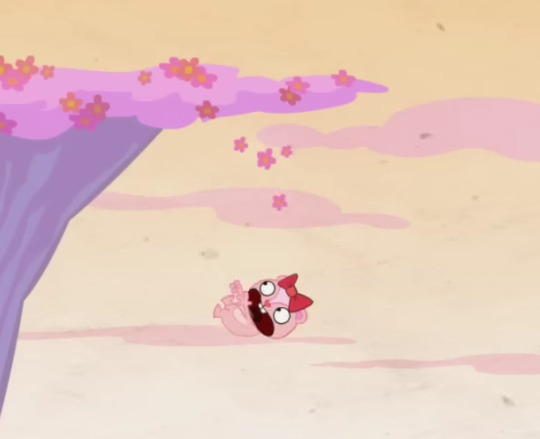

Bad luck was already in motion before Splendid got there and made it worse.
Thats why Splendid is considered one of the Isles “catalyst” residents. He’s just another bit of bad luck in motion. And Nergal takes advantage of that when it happens. It’s like Nergal sets up the dominoes and the catalyst comes in to knock ‘em over. Flippy is also often used as a catalyst resident and Lumpy’s amazing mental prowess causes him to end up being one from time to time too. Predominantly full time catalysts are fairly rare on the Isles though. Splendid ignoring the cries for help that second time around didn’t save anyone, it just took away his own involvement in their deaths is all.
Also speaking of time travel, Sniffles totally went all the way back to the DinoSore days when the curse was starting. Probably not too long before the meteor hit and set the curse of the Isles in full swing.
Right image I’d say it’s either a type of ichthyornithiformes, toothed flying birds that lived alongside their non avian dinosaur family members, or a Nemicolopterus, a small pterosaur from the Cretaceous. It died out technically before the end of the Cretaceous but I’m just working with what they give me here. To the right…..look….i have to remember that the people who worked on htf were not trying to be accurate and were just throwing around prehistoric looking animals willy nilly, but that thing looks like a drepanosaurus which was a bizarre little reptile from the Triassic period. I’m just gonna take some artistic liberties and say it’s a surviving member of that lineage that may or may not have existed during the Cretaceous and move on.
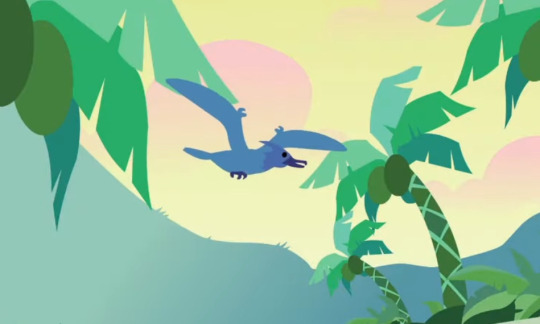



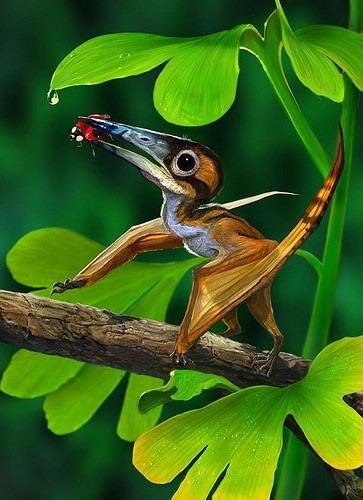
And also this guy totally lived in the trios old village and he ends up living in the First Civilization after the meteor impact I’ve decided. He may look like an anteater but he’s actually a gypsonictops. And yep, ants also existed at the time and they probably were eaten by mammals like gypsonictops. Im using Linguamyrmex vladi, the “hell ants”, just as an example cus they are cool.
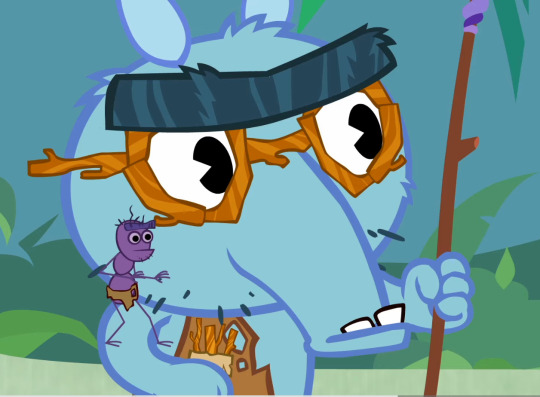
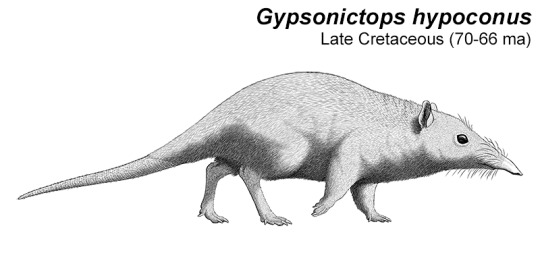

#happy tree friends#htf#htf be brave#htf lore#htf cursed idol#htf idol trio#htf splendid#htf sniffles#sorry I went on on a tangent oops#loretime#I swear to god the people who make htf keep accidentally putting in prehistoric animals that are pre mammal living alongside mammals#I know they don’t know I know that#me trying to force science into an old shock gore toon from the early 2000s?#more likely than you think…
25 notes
·
View notes
Text
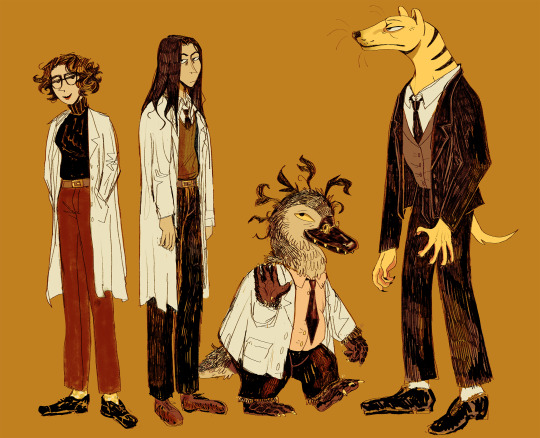
not enough moral fibre between these four to knit a small lady's handkerchief
#my art#oc#heidi#mika#mockley#coltarch#furry#anthro#i'll say it once i'll say it 1000 times i love these nasty guys and they're making me go out of my comfort zone bc I love em so ty fellas!!#forever and always trying to draw them all better i'll freakin do it man even if it kills me#figuring out heights etc. figuring out how to draw people etc. you know how it is#also been trying to design coltarch and his species as a whole for ages and i'm finally settling with this probably#he's based on thylacines and various early mammals. but mostly thylacines#he's the world's worst boss and he loves toxic work environments and also being a combination overbearing father/deadbeat dad#ummm had a nice time in krakow. i'm now a big appreciator of goulash and potato pancakes gotta be one of the comfort foods of all time#love the salt mines i want to live down there and breathe minerals forever
42 notes
·
View notes
Text
Medieval serving girl this. 18th century farm girl that. I suck up the last few drops at the bottom of my drink through a straw and suddenly I astral project into the body of a small, long-snouted, shrew-like kind of mammal sucking moisture from a drying out riverbed sometime in the Late Triassic. No worries. No burdens. Maybe bugs.
82 notes
·
View notes
Photo


Maria (she/her)
A mammal sewn in 2009. Just an unspecified mammal!
#mammal#........just mammal#plushie#toys#sewn by me#white#pastel colour#early sewing efforts#moved on
214 notes
·
View notes
Text
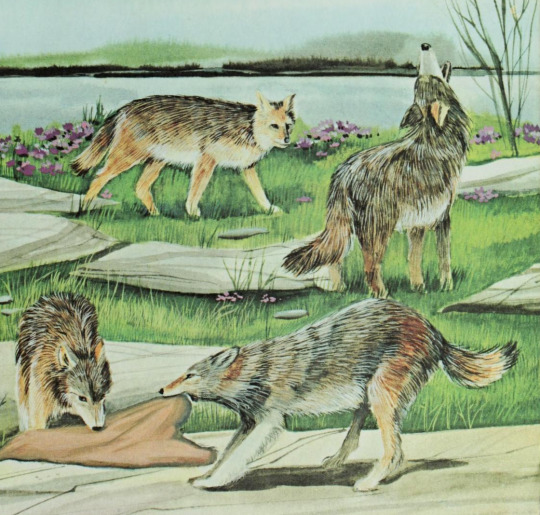
My Little Golden Book of: Dogs. Written by Jean Lewis. Illustrated by Turi MacCombie. 1983.
135 notes
·
View notes